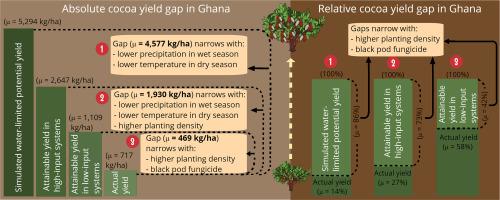Agricultural Systems ( IF 6.1 ) Pub Date : 2022-07-28 , DOI: 10.1016/j.agsy.2022.103473 Paulina A. Asante , Eric Rahn , Pieter A. Zuidema , Danaё M.A. Rozendaal , Maris E.G. van der Baan , Peter Läderach , Richard Asare , Nicholas C. Cryer , Niels P.R. Anten

|
CONTEXT
Global cocoa production is largely concentrated in West Africa where over 70% of cocoa is produced. Here, cocoa farming is largely a rain-fed, low-input system with low average yields, which are expected to decline with climate change. With increasing demand, there is a need to evaluate opportunities to increase production whilst avoiding deforestation and expansion to croplands. Thus, it is important to know how much additional cocoa can be produced on existing farmland, and what factors determine this potential for increased yield.
OBJECTIVE
The objective was to quantify the cocoa yield gap in Ghana and identify the factors that can contribute to narrowing the gap.
METHODS
We calculated the cocoa yield gap as the difference between potential yield (i. water-limited potential(Yw) quantified using a crop model, ii. attainable yield in high-input systems(YE), iii. attainable yield in low-input systems(YF)) and actual farmer yield. Both absolute and relative yield gaps were calculated. We then related each yield gap (absolute & relative) as a function of environment and management variables using mixed-effects models.
RESULTS AND CONCLUSIONS
There were considerable yield gaps on all cocoa farms. Maximum water-limited yield gaps (YGW) were very large with a mean absolute gap of 4577 kg/ha representing 86% of Yw. Attainable yield gap in high-input (YGE) was lower with mean absolute gap of 1930 kg/ha representing 73% of YE. The yield gap in low-input (YGF) was even lower with mean absolute gap of 469 kg/ha representing 42% of YF. Mixed-effects models showed that, absolute YGW were larger at sites with higher precipitation in the minor wet and minimum temperature in the minor dry season explaining 22% of the variability in YGW. These same factors and cocoa planting density explained 28% of variability in absolute YGE. Regardless of climate, absolute YGF and relative YGW, YGE and YGF were reduced by increasing cocoa planting density and application of fungicide against black pod. The models explained 25% of the variability in absolute YGF, and 33%, 33% and 25% in relative YGW, YGE and YGF respectively.
In conclusion, climate determined absolute YGW in Ghana whilst absolute YGE were determined by both climate and management. In contrast, absolute YGF and relative YGW, YGE and YGF can be reduced by agronomic management practices.
SIGNIFICANCE
Our study is one of the first to quantify cocoa yield gaps in West Africa and shows that these can be closed by improved agronomic practices.
中文翻译:

加纳的可可产量差距:量化和分析可能缩小差距的因素
语境
全球可可生产主要集中在西非,那里生产了超过 70% 的可可。在这里,可可种植主要是一个雨养、低投入的系统,平均单产低,预计会随着气候变化而下降。随着需求的增加,有必要评估增加产量的机会,同时避免砍伐森林和扩大农田。因此,重要的是要知道在现有农田上可以额外生产多少可可,以及哪些因素决定了这种增加产量的潜力。
客观的
目的是量化加纳的可可产量差距,并确定有助于缩小差距的因素。
方法
我们将可可产量差距计算为潜在产量之间的差异(i. 使用作物模型量化的限水潜力(Yw),ii. 高投入系统中可实现的产量(Y E),iii. 低投入系统中可实现的产量系统(Y F))和实际农民产量。计算了绝对和相对产量差距。然后,我们使用混合效应模型将每个产量差距(绝对和相对)关联为环境和管理变量的函数。
结果和结论
所有可可农场的产量差距很大。最大限水产量差距(YGW )非常大,平均绝对差距为 4577 公斤/公顷,占 Yw 的 86%。高投入(YG E)可达到的产量差距较小,平均绝对差距为 1930 公斤/公顷,占 Y E的 73% 。低投入(YG F)的产量差距甚至更低,平均绝对差距为 469 公斤/公顷,占 Y F的 42% 。混合效应模型显示,在次湿季降水量较高的地点,绝对 YG W较大,而在次旱季最低气温则解释了 YG W变化的 22%. 这些相同的因素和可可种植密度解释了绝对 YG E变异性的 28% 。无论气候如何,通过增加可可种植密度和对黑豆荚施用杀菌剂,绝对 YG F和相对 YG W、 YG E和 YG F都会降低。这些模型分别解释了绝对 YG F的 25% 和相对 YG W、 YG E和 YG F的 33%、33% 和 25% 。
总之,气候决定了加纳的绝对 YG W ,而绝对 YG E则由气候和管理决定。相比之下,绝对 YG F和相对 YG W、 YG E和 YG F可以通过农艺管理实践来减少。
意义
我们的研究是最早量化西非可可产量差距的研究之一,并表明可以通过改进农艺实践来弥补这些差距。











































 京公网安备 11010802027423号
京公网安备 11010802027423号